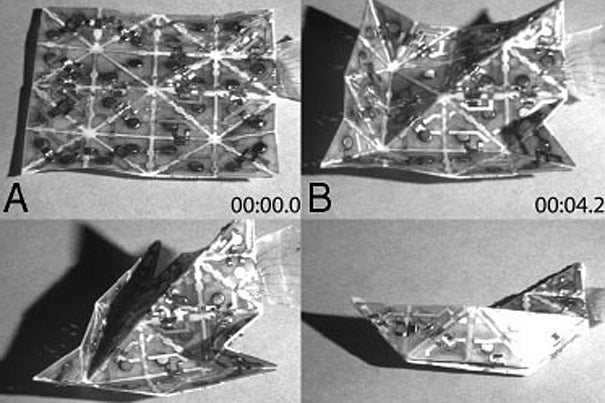Video: “Smart Sheets” Can Self-Assemble Into Airplanes, Boats
Scientists at MIT and Harvard have invented self-folding smart fiberglass sheets that can crease themselves into origami airplanes and boats....

Scientists at MIT and Harvard have invented self-folding smart fiberglass sheets that can crease themselves into origami airplanes and boats.
It’s a far cry from previous programmable matter research we’ve seen, which works at the nanoscale to create scaffolds and gears.
The fiberglass sheets are about a half-millimeter thick and made of half-inch-wide triangular tiles. They can be made at a larger scale, enabling machines that can fold, Transformer-like, into any number of objects.
Though the goal is to make large objects, the folding involves some nano-scale circuits. MIT computer scientist Daniela Rus embedded shape-memory strips, made of a nickel-titanium alloy, that were about 100 microns thick — the width of a human hair. The sheets were also outfitted with stretchable copper-laminated plastic mesh, which served as wires.
Electricity running through the copper mesh was applied to the alloy strips, which change shape at different temperatures. When the alloy strips reached 178 degrees F, they bent, taking the whole sheet with them. The sheets folded into a variety of shapes in a matter of a few seconds, and magnetic closures helped them stay in place.
Eventually, the 32-tile sheets folded into boats and airplanes. Rus says the key was figuring out algorithms for folding. It was like learning origami, she says in a press release — “We determine, based upon the desired end shapes, where to crease the sheet.”
To make the folds, the team came up with thin stickers that contained the circuitry required to spur the alloy strips into action. Though the current design uses a computer, future designs will allow multiple stickers that can be changed without any computer programming. If you want a boat, you use one sticker; for a fork, use a different sticker.
The goal is to make sheets that could fold into multiple items, like a dining utensil set or a “Swiss Army Knife” tool kit.
More than meets the eye, indeed.